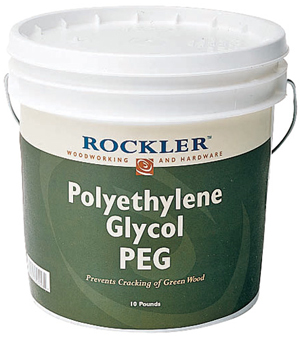
A few years back, I read an article in a woodworking magazine where anti-freeze was used to cure green wood. I can’t remember the procedure. Do you know anything about this?
Michael Dresdner: No, but if I had to guess, I’d say that someone is confusing two or three similar chemicals.
Antifreeze contains ethylene glycol (EG), which is poisonous. “Safe” antifreeze, commonly sold as “Sierra” or as RV antifreeze, is a very edible compound called propylene glycol (PG). Green wood is often treated by soaking it in a waxy water replacement compound called polyethylene glycol (PEG). I could see how someone could confuse these three, as their names have serious similarities.
I’ve never run across anyone using either EG or PG to do the job that PEG does so well — stabilizing green wood. PG in particular is a humectant — a compound that keeps things moist, (we use it in our cigar humidors to keep the cigars from drying out) so I suspect it would be counterproductive for water replacement during wood drying, but it would slow down the process, perhaps minimizing checking.
Lee Grindinger: Antifreeze is ethylene glycol. The substance you’re referring to which stabilizes green lumber is polyethylene glycol, or PEG. Antifreeze is lethal poison. Although sharing the same molecule, these are two very different substances and not to be confused with each other. The PEG string of molecules is small enough to penetrate the wood tissue over time and displace the water. Once the PEG is in place it prevents the wood from shrinking as the wood dries. The specific PEG formulation you’re looking for is PEG 1000. This will work only with green wood and the wood must be porous enough to absorb the PEG. Fully submerge the wood in the PEG 1000 and give it plenty of time, weeks actually, to displace the water. Different woods and different thicknesses will require different times.







